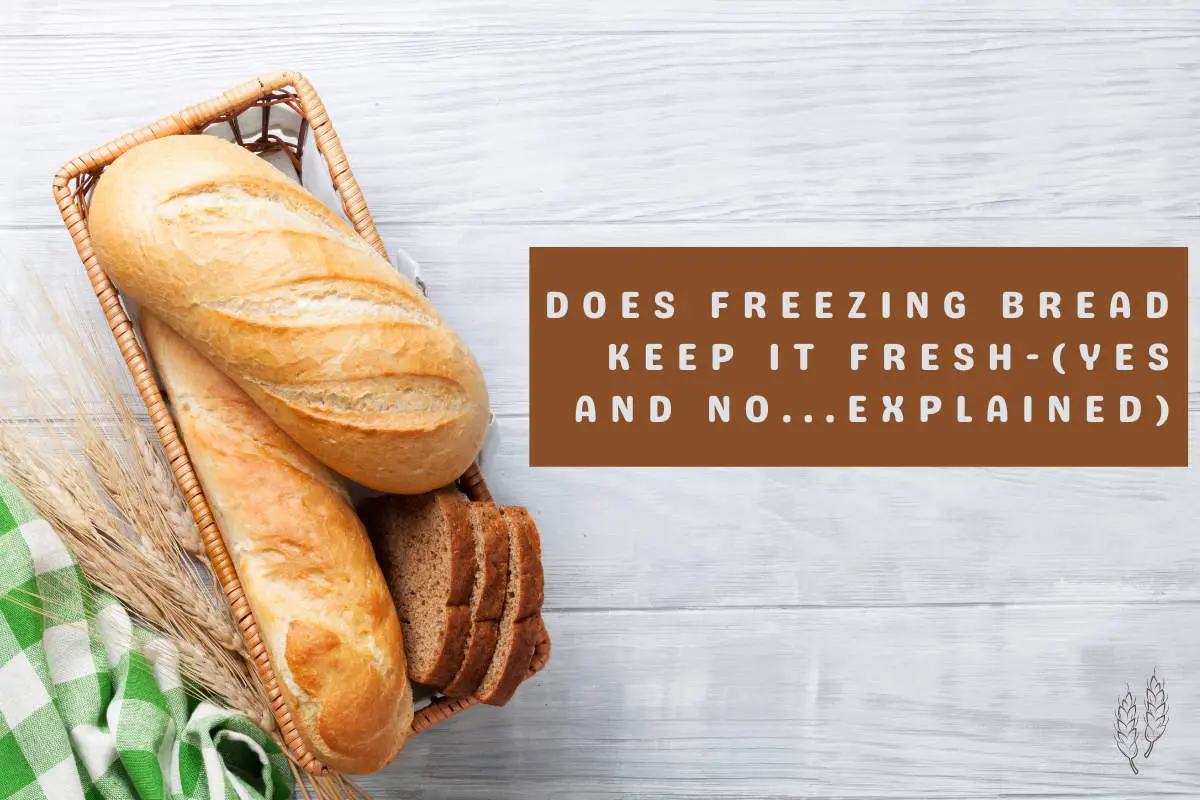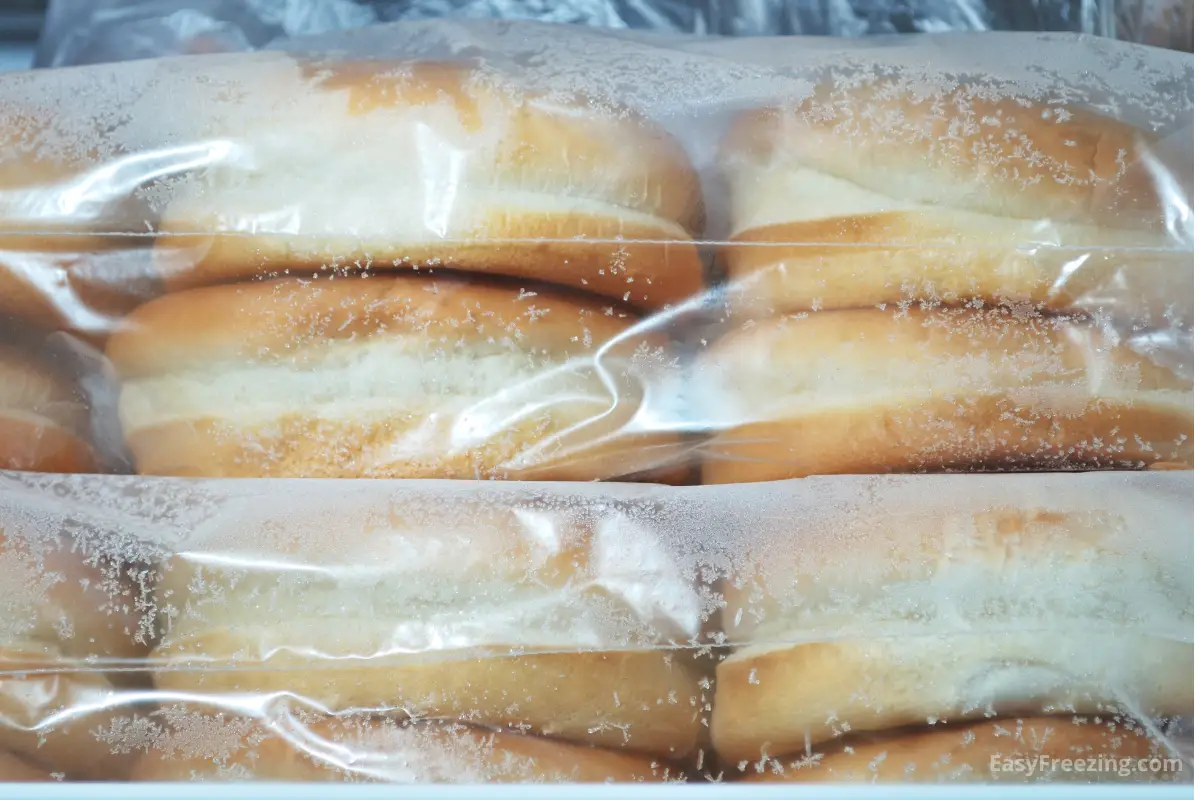Does Freezing Bread Keep It Fresh- (Yes And No…Explained)
From your basic peanut butter and jelly sandwiches to those fluffy baguettes and fresh toasts, bread is something every household loves to have.
Being a staple food in many countries around the globe, bread can be either prepared at home or bought fresh from the market. However, when it comes to its shelf life, a loaf of bread doesn’t last more than four days if kept at room temperature.
It might sound strange to you at first, but freezing bread can indeed keep it fresh for much longer. Wish to know how the magic of a deep freezer can keep your bread from getting stale and growing mold? Read on to find out!

What Happens When You Freeze Bread
When you place fresh bread inside a freezer bag and pop it into the freezer, the first thing that happens is the slices start to freeze together. The benefit, of course, is that since the freezer bag does not allow airflow, the bread doesn’t go stale.
Additionally, the extremely cold temperature does not allow mold and fungus to form, thus keeping the bread itself fresh and safe to eat for periods of up to six months.
Things To Consider When Freezing Bread

Here are some key points to keep in mind before you freeze a slice or loaf of bread:
Freezer Bread: Be Prepared For Changes
Keeping the bread fresh for longer than usual might sound like a good deal. But, it comes with a price. The con we are talking about here is the negative changes in taste and texture. The bread will likely begin drying out over time, and the crust may also become less crunchy and flavourful.
Having said that, if you have several loaves of bread you’d like to store long-term, freezing it is still the way to go.
Tip- It is advised not to freeze bread like ciabatta and baguettes as they might not stay fresh for long even after being kept in the freezer.
Freeze Bread, Don’t Refrigerate It
Much like other foods which can be saved if you stash them in a refrigerator, keeping bread loaves in the fridge might not be the best idea. While a refrigerator will slow down the speed at which bread goes bad (and is better than keeping it on the kitchen counter), it is not the ideal place for long-term storage as the bread will dry out, and bacteria like mold can still grow.
Thus, if you’re looking to store bread to use later, you can put it in the freezer instead: Freeze, do not refrigerate! This is because bread stops all its internal changes and stale-making processes at and below freezing temperatures.
Fact- The scientific term for the process where your bread starts to become stale is “retrogradation and re-crystallization of starch.” This process is catalyzed when bread is refrigerated at cold temperatures that are above freezing but below room temperature.
Store Bread in The Freezer With Care
Freezing your bread at 0 degrees Fahrenheit will keep it from going stale for between 3 to 6 months.
I highly recommend storing your bread wrapped up separately from other food items or that you consider investing in a freezer-safe bread box (Amazon).
These boxes offer an airtight seal that will protect your bread from the cold freezer air and the possibility of it taking on the flavor of other items stored in your freezer.
Frozen Bread: The Nutrition Farewell
Freezing bread for a long period of time can cause the process of oxidation to change the texture of the bread. It can also cause a loss of nutrients.
When kept in cool air for long hours, the trapped air pockets in direct contact with the bread begin to oxidize. This results in the release of water-soluble nutrients present in bread, such as Vitamin C, folic acid, thiamin, and riboflavin. Avoid this by making sure that the bread is properly packaged.
So let’s look at how to package, freeze and thaw bread the right way, step-by-step.
Easy Guide To Freezing And Thawing Bread

If you are considering freezing your bread, here’s an easy guide on how to do it right.
Freezing Bread Step-by-Step Instructions
- The very first step is to make sure that your bread is completely dry and at room temperature.
- The next step is to take an airtight freezer bag and pack your loaf of bread in it (This applies to any type of bread, whether it be loaves, buns, or slices). Make sure to push out as much of the excess air as possible and then seal your bag tightly.
- Stash your bags in the freezer where there is no direct flow of cool air (i.e., not right next to the blower).
- Always write the date of freezing on your zipper bag so that you can keep track of how long the bread has been frozen.
Thawing Bread: How To
- Take the bread out of the freezer and keep it in the refrigerator so that it slowly comes to a normal temperature.
- The suggested time for refrigerating is 2-3 hours for slices and overnight for a whole loaf.
- Your bread is ready to be used. Enjoy!
Bonus: Heartwarming Bread Recipes
If you’d like to make and freeze your own homemade bread, you won’t be able to resist trying out these delicious bread recipes. Read on and try it today!
Fluffy Milk Bread
Indulge yourself in the taste of this milky bread that is rich in calcium and carbohydrates. Perfect for breakfast!
Garlic Bread
Want to cook Italian? Try this amazing garlic bread recipe. Garnish with veggies, cheese, or herbs, and enjoy the blend of softness and Italian flavors.
Multigrain Bread
Encourage your health-conscious mind and try a multigrain bread that’s full of fiber, protein, zinc, and vitamins.
Does Freezing Bread Keep It Fresh – Wrapping Up
The fact is that bread kept in the freezer will never be as good as fresh bread straight from the oven or market. However, if you find yourself with excess packages of bread, storing it in the freezer will be your best bet for longer-term storage.
If you thaw and eat the frozen bread within the first 3 months, you’ll still get to enjoy great-tasting bread without running to the store or needing to start a new bake.







